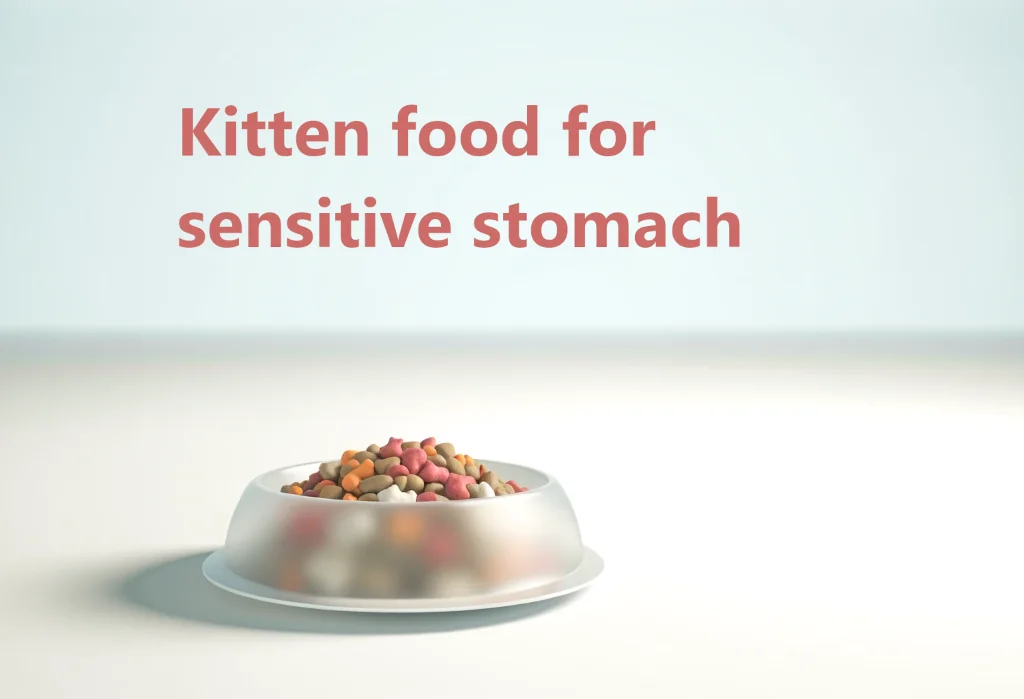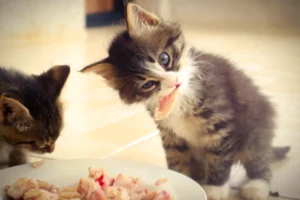Disclosure: We may earn a commission from helpful, relevant links in our content. No cost to you. See our privacy policy.
Watching your kitten struggle with a sensitive stomach can turn meal times into a game of Russian roulette with food choices. It’s like trying to solve a puzzle without seeing the picture on the box – frustrating, to say the least.
In this blog post, you’ll learn how to pick the best kitten food for those with sensitive stomachs, helping to turn those risky meal times into peaceful moments for both you and your feline friend.
Key takeaways:
- Choose kitten food with a single protein source and consider grain-free options for easier digestion.
- Introduce new food gradually over 10 days to prevent stomach upset.
- Observe your kitten closely for any adverse reactions to their diet, and consult your vet if issues persist.
What Makes a Kitten’s Stomach Sensitive?
Ever wonder why some kittens can smoothly transition from milk to solid food, while others seem to have a tougher time adjusting? Well, a lot has to do with their delicate digestive systems. Dietary intolerances play a significant role in a kitten’s stomach sensitivity. Just like humans, kittens can react poorly to certain ingredients in their food, leading to an upset stomach or diarrhea.
Rapid dietary changes are another culprit. Think of it as a stomach shock. Introducing new foods too quickly can overwhelm a kitten’s digestive system, which hasn’t fully developed its ability to handle a wide range of foods.
Lastly, we can’t overlook underlying health issues. Conditions like parasitic infections or congenital abnormalities, though less common, can significantly contribute to gastrointestinal sensitivity. It’s always best to consult with a vet if you’re unsure why your kitten’s stomach is acting up.
What Should You Look for in Kitten Food for Sensitive Stomachs?
So, you’ve got a sensitive kitten on your hands. What’s next? Choosing the right food can make all the difference. Here’s what to keep an eye out for:
-
Single protein sources : Foods that feature one primary protein source are easier on the stomach. Chicken, turkey, or lamb are good options, as they are less likely to cause an upset compared to those with multiple protein sources.
-
Grain-free options : While not all kittens are sensitive to grains, grain-free formulas can be kinder to a sensitive stomach, reducing the risk of digestive issues.
-
Probiotics and dietary fibers : Probiotics aren’t just a human health craze; they’re beneficial for kittens too! They aid digestion and help maintain a healthy gut flora. Similarly, dietary fibers support digestive health by promoting regular bowel movements.
-
Hydration : Wet food can be a game-changer for kittens with sensitive stomachs, ensuring they stay hydrated and facilitating easier digestion.
A real-world example of a kitten food that ticks all these boxes is the Royal Canin Feline Health Nutrition Sensitive Digestion dry cat food. It’s formulated specifically for cats and kittens with sensitive stomachs and includes easily digestible proteins and prebiotics.
How Can You Introduce New Food to Your Kitten’s Diet Slowly?
Patience is key when transitioning your kitten to a new diet. Here’s a straightforward plan to make the switch as smooth as possible:
-
Day 1-3 : Mix 25% of the new food with 75% of the old food. Keep an eye on your kitten’s reaction to the change.
-
Day 4-6 : Increase the ratio to 50% new food and 50% old food. By now, your kitten should start getting used to the taste and texture of the new food.
-
Day 7-9 : Shift the balance further to 75% new food and 25% old food. Monitor your kitten for any signs of stomach upset during this period.
-
Day 10 : Make the complete switch to 100% new food.
Throughout this process, it’s vital to observe your kitten for any signs of distress, like diarrhea or vomiting. If you notice any adverse reactions, slow down the transition process, or consult with your vet for advice.
By taking things slow and steady, you’re easing the burden on your kitten’s sensitive stomach, allowing it to adjust without unnecessary stress. Remember, every kitten is different, so some may need a little more time to adapt than others. Your patience and attentiveness during this period will go a long way in ensuring your kitten’s dietary switch is successful and as comfortable as possible.
What Are the Signs Your Kitten’s Food Isn’t Right for Them?
Spotting the warning signs that your kitten’s current diet might be more of a foe than a friend is crucial in ensuring they lead a happy, healthy life. Not every kitty’s tummy is made the same, and some may have adverse reactions to foods that others may gobble down with gusto. Here are the telltale signals that it’s time to reassess what’s in their food bowl:
- Diarrhea and Vomiting: The most apparent and concerning symptoms that something’s not sitting well. If your kitten often finds themselves in discomfort post-mealtime, it’s a clear indicator that their food may not be agreeing with them.
- Lethargy: A kitten full of energy is what you’d expect. If they’re not bouncing off the walls and seem more inclined to snooze than play, it’s worth considering whether their diet is to blame.
- Poor Coat Quality: Nutrition directly affects coat health. A shiny, thick fur coat gives way to a dull, brittle one when a kitten isn’t getting the right nutrients.
- Weight Loss or Poor Weight Gain: If you’re noticing your kitten isn’t hitting the growth milestones they should be, or worse, losing weight, it’s a red flag that their nutritional needs aren’t being met.
Remember, these symptoms could also indicate other health issues, so it’s paramount to consult with your vet to rule out any underlying conditions.
How Often and How Much Should You Feed a Kitten With a Sensitive Stomach?
Managing a kitten’s sensitive stomach goes beyond just picking the right food; how and when you feed them plays a pivotal role as well. Let’s dive into some feeding strategies to help your little feline friend thrive:
Frequency:
Young kittens have tiny tummies but big energy needs. Splitting their daily food intake into multiple smaller meals—around three to four times a day—can help ease digestion and avoid overwhelming their delicate digestive systems. As they grow older, transitioning to two meals a day is generally recommended.
Portion Size:
Measuring meals is key to preventing overfeeding, which can exacerbate stomach sensitivity issues. Follow the feeding guidelines on the kitten food packaging as a starting point, but keep in mind that each kitten’s needs may differ. Monitoring their weight and growth can help you adjust portions as needed.
Consistency is Key:
When you’ve found a diet that suits their sensitive stomach, stick with it. Frequent changes in diet can unsettle their tummy further. If a diet switch is required, do it gradually over a week to give them time to adjust.
Unique Tip:
Bowl placement can unexpectedly impact digestion. Elevating your kitten’s food bowl slightly can promote a more natural eating posture, reducing the risk of gulping air—a minor detail with major benefits for sensitive stomachs.
Feeding a kitten with a sensitive stomach doesn’t have to be a daunting task. With a bit of care and attention to their diet and feeding regime, you’ll be able to support their digestive health effectively. Remember, when in doubt, your vet is your best resource for tailored nutritional advice.
Alex, a passionate animal lover, has experience in training and understanding animal behavior. As a proud pet parent to two dogs and three cats, he founded AnimalReport.net to share insights from animal experts and expand his knowledge of the animal kingdom.





